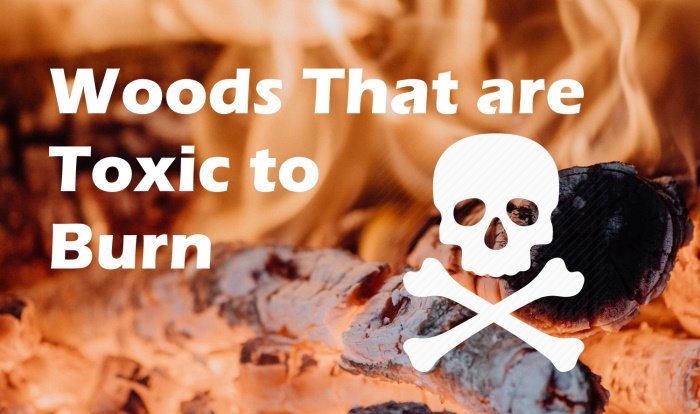
Outdoor fireplaces are an incredible source of heat, providing the much-needed warmth for a comforting atmosphere in winter.
However, to create a real wood fire, you must have firewood at your disposal.
But not all types of wood are suitable for use as firewood. If you were not aware, some are toxic to burn and will produce harmful substances that can potentially endanger your health.
With nearly endless types of wood to choose from, finding a tree that makes the perfect firewood can be a labor-intensive and intimidating task.
So, what woods are toxic to burn?
To help you out, we are going to provide you with an extensive list of some of the woods you should never burn in your fireplace.
Green or Unseasoned Wood
When a tree is cut down, the timber needs to season or age for a period of six or nine months before burning.
Also known as green wood, freshly cut woods usually contain lots of sap which is mostly water and needs to dry out first. Greenwood is not only difficult to lit, but also produces ridiculous amounts of smoke.
Wood smoke is made of a mixture of particles and chemicals, including volatile organic compounds, carbon monoxide, nitrogen oxides as well as Sulphur dioxide among others.
Wood smoke affects the quality of both indoor and outdoor air. It features both fine and coarse particles.
Fine dust particles such as smoke itself are increasingly likely to settle deeply into your lungs whereas ultrafine particles may be absorbed into your bloodstream.
On the other hand, coarse particles such as pollen, dust, and soot, when inhaled, will settle in both your lungs and narrow pathways.
If you aren’t sure whether the wood is green or not, don’t hesitate to ask the seller when it was cut. While all firewood will create some amount of creosote, freshly-cut ones will always emit the most.
Driftwood
Driftwood is a type of wood that has been washed onto a shore of a river, lake, or sea through the action of waves, tides, or winds. But, what’s wrong with burning driftwood in your fireplace?
Assuming the driftwood originated from the ocean, the chances are high that it will contain lots of chlorine. Chlorine is a compound of sodium chloride, commonly known as salt.
So, when you burn driftwood in your fireplace, the chlorine content will be converted into toxic chemicals, some of which have been suggested to cause cancer as well as other health conditions.
And if you thought driftwood from freshwater is safe to burn in your fireplace, you are in the wrong place!
Though it may not contain salt, it contains a lot of moisture which will not only prevent it from burning efficiently but will equally make it to produce lots of smoke.
Pressure-Treated Wood
Oleander
Oleander is one of the most gorgeous trees out there. It has slender trunks with long, deep-green leaves that are equally shiny and vibrant.
However, it is imperative to note that despite its beautiful appearance, oleander wood, when burned, produces toxic smoke that can cause intoxication.
Animals as well as humans are highly sensitive to their high level of toxicity. Its smoke can affect your heart, gastrointestinal, and nervous systems.
Chipboard or Plywood
There’s a lot of cheap furniture out there that is made with chipboard, that is held together using high-strength adhesives.
Burning adhesive-filled woods in your fireplace will only release unwanted toxins in your environment. The same applies to wood pallets, and stained or painted wood, which is known to contain toxic chemicals that get released when they are burned and are harmful to your health.
Softwood
Because of its somewhat higher resin content, you should never burn softwood in your fireplace.
Burning softwoods usually results in the production of dark, thick smoke that not only clogs your chimney, but pollutes the environment as well.
Typical examples of softwoods include fir, pine, western red cedar, and cypress among others.
They usually burn relatively faster, and makes a lot of smoke that will ultimately coat both your chimney and lungs!
Endangered Tree Species
Although they are not necessarily toxic to burn, there are a number of trees that are at a greater risk of decline, and you need to know them to ensure you don’t chop them down.
It is best not to burn them, especially if you have other available options.
The decline in some tree species is due to increased logging combined with a lack of fire.
In case you didn’t know, there are some trees such as the Longleaf Pine, that will only germinate after a major forest fire!
Other species, such as the Red Oak, are prone to fungi attacks.
The Fraser Firs is another endangered species because of an insect known as the woolly balsam Adelgid. Once this particular insect attacks and infects the tree, it will ultimately starve to death.
